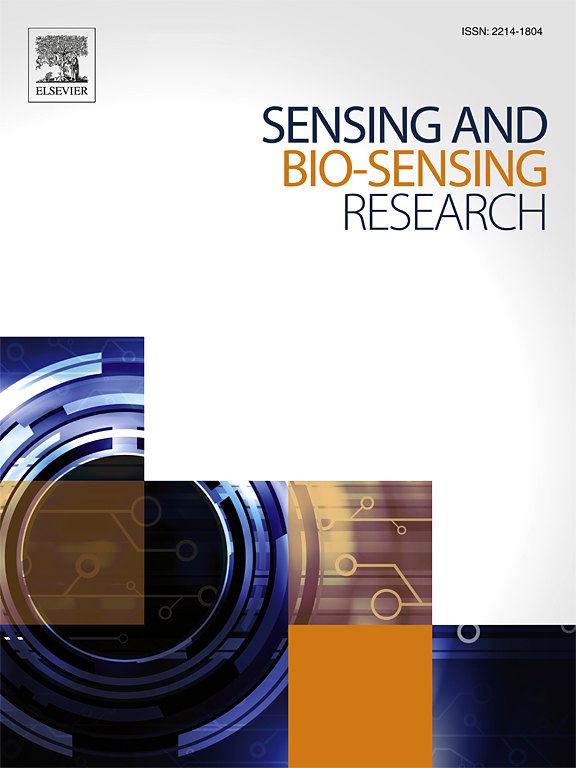Ultra-sensitive terahertz photonic crystal fiber sensor for detection of tuberculosis
IF 4.9
Q1 CHEMISTRY, ANALYTICAL
引用次数: 0
Abstract
Tuberculosis (TB), a contagious disease spread through bacteria Mycobacterium tuberculosis, be possibly most leading contagious and deadly illnesses globally. Tuberculosis exhibited the highest mortality rate among all single infections, surpassing that of HIV/AIDS. Timely identification is a crucial element in the management of patients and possesses the capability to boost the likelihood of enduring. Detecting systems should possess exceptional mobility, accuracy, rapid detection capabilities, and minimal losses. This study introduces an innovative biomedical PCF sensor that can precisely identify and differentiate several strains of tuberculosis bacteria. The sensor relies on the sensitivity of terahertz radiation and advanced PCF design to overcome the limitations of existing diagnostic techniques. The sensor specifically targets the distinct difficulties associated with tuberculosis detection, a significant worldwide health issue. The sensor that has been designed exhibits a high relative sensitivity (ranging from 99.72 % to 99.95 %) and minimal losses when compared to previous detectors incorporating PCF. The sensor being considered demonstrates a CL of 5.17 × 10−03 cm−1, an impressively minimal EML of 0.0010 cm−1, and NA of 0.217. This sensing unit under consideration can function within the terahertz frequency range. Consequently, it serves as a valuable resource for healthcare providers, enhancing their diagnostic capabilities for prompt treatment and improved patient outcomes. Additionally, its compact size enables its use in time-sensitive scenarios.
用于肺结核检测的超灵敏太赫兹光子晶体光纤传感器
结核病(TB)是一种通过结核分枝杆菌传播的传染病,可能是全球最主要的传染性和致命性疾病。在所有单一感染中,结核病的死亡率最高,超过了艾滋病毒/艾滋病。及时识别是患者管理的关键因素,并具有提高持久可能性的能力。检测系统应具有特殊的机动性、准确性、快速检测能力和最小的损失。本研究介绍了一种创新的生物医学PCF传感器,可以精确识别和区分几种结核病菌株。该传感器依靠太赫兹辐射的灵敏度和先进的PCF设计来克服现有诊断技术的局限性。该传感器专门针对与结核病检测相关的明显困难,这是一个重大的世界卫生问题。所设计的传感器具有较高的相对灵敏度(范围从99.72%到99.95%),与以前的结合PCF的探测器相比,损耗最小。所考虑的传感器显示出5.17 × 10−03 cm−1的CL,令人印象深刻的最小EML为0.0010 cm−1,NA为0.217。考虑中的传感单元可以在太赫兹频率范围内工作。因此,它为医疗保健提供者提供了宝贵的资源,增强了他们的诊断能力,以便及时治疗并改善患者的预后。此外,其紧凑的尺寸使其能够在时间敏感的情况下使用。
本文章由计算机程序翻译,如有差异,请以英文原文为准。
求助全文
约1分钟内获得全文
求助全文
来源期刊

Sensing and Bio-Sensing Research
Engineering-Electrical and Electronic Engineering
CiteScore
10.70
自引率
3.80%
发文量
68
审稿时长
87 days
期刊介绍:
Sensing and Bio-Sensing Research is an open access journal dedicated to the research, design, development, and application of bio-sensing and sensing technologies. The editors will accept research papers, reviews, field trials, and validation studies that are of significant relevance. These submissions should describe new concepts, enhance understanding of the field, or offer insights into the practical application, manufacturing, and commercialization of bio-sensing and sensing technologies.
The journal covers a wide range of topics, including sensing principles and mechanisms, new materials development for transducers and recognition components, fabrication technology, and various types of sensors such as optical, electrochemical, mass-sensitive, gas, biosensors, and more. It also includes environmental, process control, and biomedical applications, signal processing, chemometrics, optoelectronic, mechanical, thermal, and magnetic sensors, as well as interface electronics. Additionally, it covers sensor systems and applications, µTAS (Micro Total Analysis Systems), development of solid-state devices for transducing physical signals, and analytical devices incorporating biological materials.
 求助内容:
求助内容: 应助结果提醒方式:
应助结果提醒方式:


